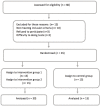Stroke Patients Showed Improvements in Balance in Response to Visual Restriction Exercise
- PMID: 35036254
- PMCID: PMC8752821
- DOI: 10.1298/ptr.E10081
Stroke Patients Showed Improvements in Balance in Response to Visual Restriction Exercise
Abstract
Objective: Several strategies have been designed to improve balance after stroke. Although recent studies have suggested that the balance training in stroke should include exercises that are performed in different sensory conflict conditions, little attention has been paid to manipulation of visual input. This study aimed to compare effects of balance training on an unstable surface with balance training under visual deprivation conditions in persons with stroke.
Method: Forty-five stroke patients were randomized into three groups: the visual deprivation- stable based training (VD-SBT); unstable based training (UBT); and control (C) groups. Subjects of the VD-SBT group performed balance training on a stable surface with closed eyes. The UBT group performed balance training on an unstable surface with open eyes. Patients were assessed before and after interventions for Timed Up and Go (TUG), Four Square Step (FSS) and Five Times Sit to Stand (FTSS) tests.
Result: There was a significant difference in pre- post intervention time of TUG, FSS and FTSS tests in all three groups. In a comparison of three groups, the UBT and VD-SBT groups had a significant improvement in time of all tests but significant improvement in time of all tests was observed in the VD-SBT group in comparison with the UBT group. In the field of balance training, the manipulation of visual input was more effective than the manipulation of standing surface to reweighting the sensory information.
Conclusion: We recommended balance rehabilitation programs after stroke performed under conditions to stimulate the use of underused sensory input.
Keywords: Balance training; Sensory integration; Stroke; Visual deprivation.
2021, JAPANESE PHYSICAL THERAPY ASSOCIATION.
Conflict of interest statement
There is no conflict of interest to disclose.
Figures



References
-
- Susan B. O'Sullivan, Thomas J. Schmitz, et al.: Assessment and treatment. Chap 15. In: Margaret M. Biblis, Melissa A. Duffield (eds). Physical rehabilitation. 6th ed, F.A. Davis Company, 2014, pp. 645-647.
-
- Sarti C, Rastenyte D, et al.: International trends in mortality from stroke, 1968 to 1994. Stroke. 2000; 31: 1588-1601. - PubMed
-
- Ziemann U: Improving disability in stroke with rtms. The Lancet Neurology. 2005; 4: 454-455. - PubMed
-
- Winter DA: Human balance and posture control during standing and walking. Gait & posture. 1995; 3: 193-214.

